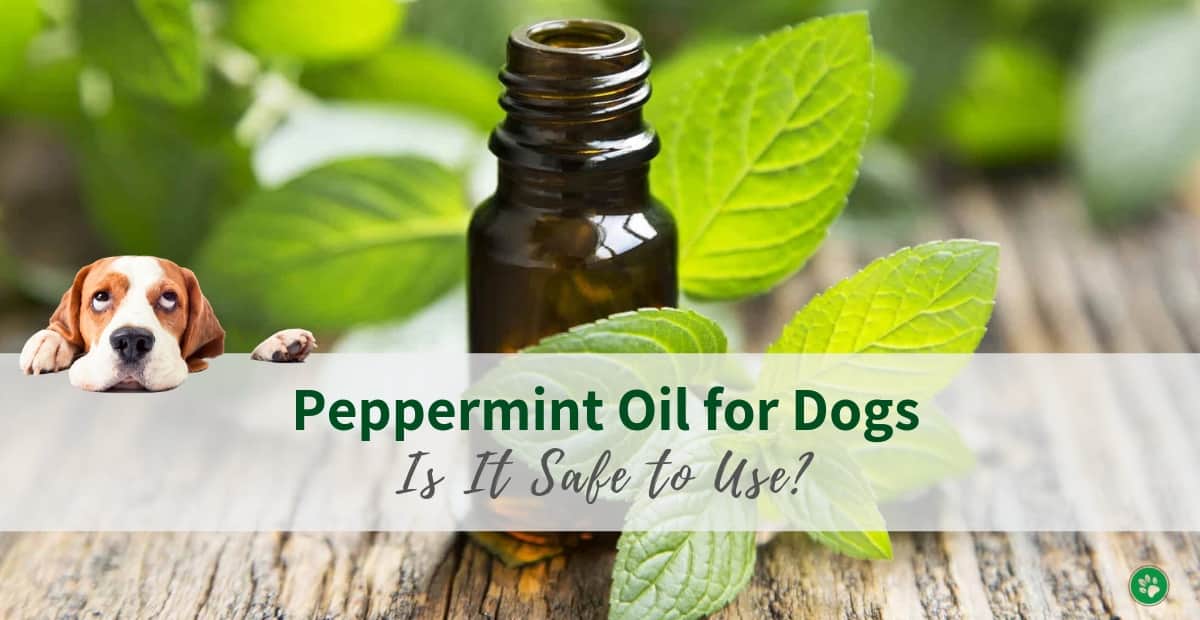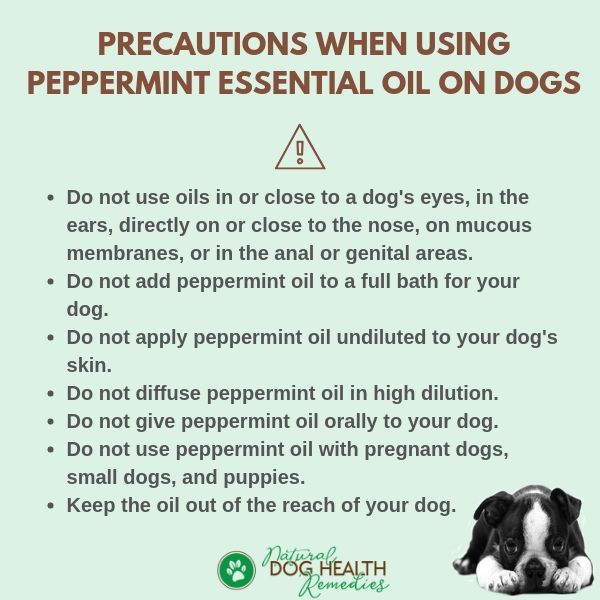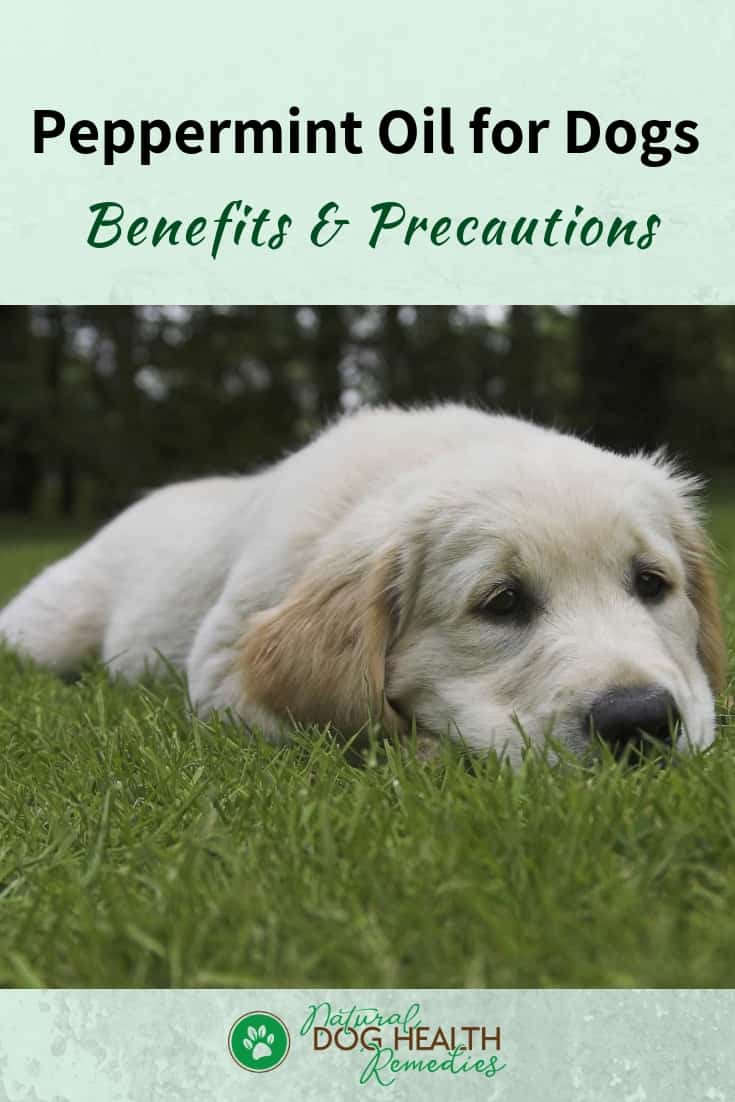Is Peppermint Oil Safe for Dogs?

Overview
I have received quite a few emails from visitors to my site asking me if peppermint essential oil is safe for dogs. There are a lot of sites on the Internet that categorically say peppermint oil is unsafe for dogs.
Very often, however, whether a particular essential oil is "safe" to use on dogs is not that clear cut. That an oil is "unsafe to ingest" doesn't mean that it is unsafe to use topically. It is also true that if used incorrectly, even a "safe" oil such as lavender may cause harm to your dog!
In my opinion, peppermint oil is getting an unfair "bad rap", because if we take precautions and use the oil knowledgeably, we can put the oil to some good use!
With that in mind, I am writing this article to address the following:
- What's in Peppermint Essential Oil?
- Safety Precautions to Take When Using Peppermint Oil on Dogs
- Therapeutic Properties of Peppermint Oil
- How We Can Use Peppermint Oil Safely with Dogs
What's In Peppermint Essential Oil?
The essential oil of Peppermint (Mentha x piperita) consists mainly of alcohols and ketones.
Peppermint has a very high menthol content. (Menthol is an alcohol.) Depending on the batch of oil, the menthol content can range from 35% to 50%.
We all know that menthol has a cooling effect, but it can also be skin irritating, especially if applied to the skin undiluted. You may feel chilled or a "burning-cold" sensation on the skin.
Peppermint oil also contains between 20-40% menthone (which is a ketone). Menthone is stimulating to the central nervous system. It is also anti-inflammatory and pain relieving.
Safety Precautions When Using Peppermint Oil with Dogs
Because of the high menthol content, peppermint oil can be irritating to the skin and mucous membranes.
It can also cause breathing and respiratory problems - The menthol in the oil can cause spasm resulting in breathing difficulty.
In view of the above, we should take the following safety precautions when using peppermint essential oil with our dogs. In particular:
- Do not put peppermint oil on a dog's face, especially near the eyes, nose, and mouth. Also do not apply the oil near the genital and anal areas.
- Do not add peppermint oil to a full bath for your dog (or yourself). Due to its skin irritating and cooling effects, it can cause reddening of the skin and a burning-cold sensation.
- Do not apply peppermint oil undiluted to your dog's skin. Peppermint oil is best used in a blend, and in very low dilution (no more than 1% for dogs).
- Do not diffuse peppermint oil in high dilution. If you choose to diffuse peppermint oil, do not let your dog too close to the diffuser.
- Do not give peppermint oil (or any essential oil for that matter) orally to your dog.
- Do not use peppermint oil with pregnant dogs, small dogs, and puppies.
- Keep the oil out of the reach of your dog (and children). You don't want your dog (or kids) to ingest the oil or get it in their eyes, nose or mouth!

Therapeutic Properties of Peppermint Oil
Now that we have dealt with the safety issues, let's take a look at the therapeutic properties of peppermint oil.
As mentioned above, peppermint oil is anti-inflammatory and pain relieving. It can improve blood circulation to the areas of application.
It is astringent as its cooling effect contracts and tightens the tissues.
It is also antiseptic and antibacterial. In addition, it can repel insects such as fleas, flies, and mosquitoes.
Peppermint oil is good for the digestive system. It is carminative (gas relieving) and can counteract nausea and vomiting.
Uses of Peppermint Oil on Dogs
Some common uses of peppermint oil on dogs include:
Helps Dogs with Motion Sickness If your dog has car sickness, try putting one to two drops of pure peppermint oil on a piece of Kleenex or a cotton ball and put it in front of the air vent in the car. The scent of peppermint oil may just be the thing that prevents nausea and/or vomiting in your dog.
If your dog has car sickness, try putting one to two drops of pure peppermint oil on a piece of Kleenex or a cotton ball and put it in front of the air vent in the car. The scent of peppermint oil may just be the thing that prevents nausea and/or vomiting in your dog.
Peppermint's cooling effect is great for alleviating acute "hot" pain (e.g. sprain, muscle spasm, swelling). Use it in a blend with other anti-inflammatory oils (e.g. Lavender, Roman Chamomile, Sweet Marjoram) and dilute the oil blend with a carrier oil (e.g. aloe vera gel, jojoba).
Here is a recipe that you may want to try.
You Need:
- 8 drops Roman Chamomile (Chamaemelum mobile)
- 5 drops Lavender (Lavandula angustifolia)
- 5 drops Sweet Marjoram (Origanum majorana)
- 3 drops Sweet Orange (Citrus sinensis)
- 3 drops Peppermint (Mentha x piperita)
Blend the above essential oils into 4 oz (120 ml) of aloe vera gel. Use it to massage the affected areas on your dog.
(FYI: If your dog has chronic muscle or joint pain, it is better to use a "warming" oil, such as ginger or black pepper essential oil.)
Soothes Bug BitesIf your dog has been bitten or stung by an insect, and has intense itching and/or pain, try adding a drop of peppermint oil to a tablespoon of aloe vera gel, and apply it to the bite. The oil can cool down and soothe the pain, and at the same time it can alleviate the itch.
Soothes SunburnsThe cooling effect of peppermint oil also makes it a great addition to a soothing gel for sunburns. If your dog has been sleeping in the sun for a long time and got a crispy tummy, try this recipe.
You Need:
- 1 drop Peppermint
- 2 drops Sweet Orange
- 3 drops Lavender
Add the above essential oils to 1 oz (30 ml) of aloe vera gel. Mix well. Apply this to the affected areas 2-3 times daily until the skin heals.

Peppermint Oil Alternatives
What if, for whatever reason, you don't want to use peppermint oil on your dog? Are there any other oils that have similar properties to those of peppermint oil that you can use instead?
Of course. Here are some examples.
If your dog cannot use the essential oil of peppermint, try the hydrosol of peppermint. (Don't know exactly what hydrosols are? Visit this page.)
The hydrosol of peppermint is also cooling, so you can use it as a cold compress on muscle sprain, spasm, or other acute pain. You can also use the peppermint hydrosol as a cooling compress on sunburns.
The essential oil of balsam copaiba (Copaifera officinalis) also has a cooling effect, and has anti-inflammatory, antispasmodic, and pain relieving properties. It can be used in blends for muscle pain, sprain, swelling, etc.
For motion sickness, you can use 1-2 drops of ginger essential oil in a tablespoon of jojoba oil and use it to massage your dog's tummy, "armpits", chest and back of his neck.
For insect bites, spot apply undiluted lavender oil to the bite.
In Summary...
As you can see, used properly and with safety precautions in mind, peppermint oil is not totally unsafe to use on dogs.
Having said that, and as I have repeatedly emphasized in several other essential-oil related articles, all dogs are different and they react differently to even the same oil.
Therefore, do bear that in mind when you use peppermint oil (or any other oil for that matter) for the first time with your dog.
Be sure to do patch tests, use the oil in low dilution, and observe your dog carefully for any possible adverse reaction.
Also, as with any other essential oils, use only 100% pure oil.





